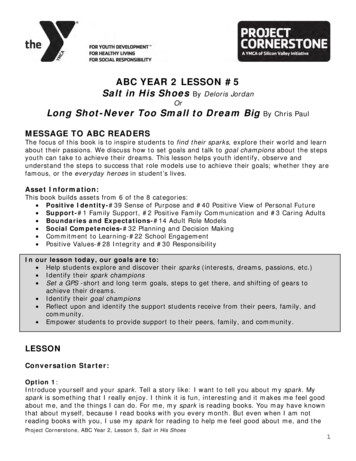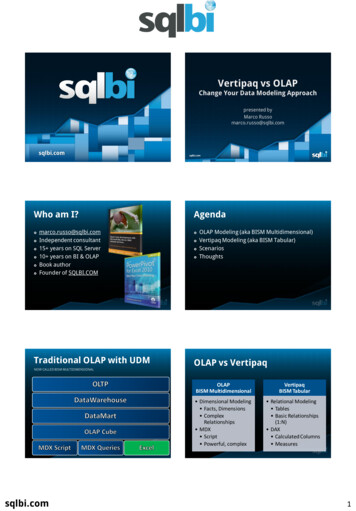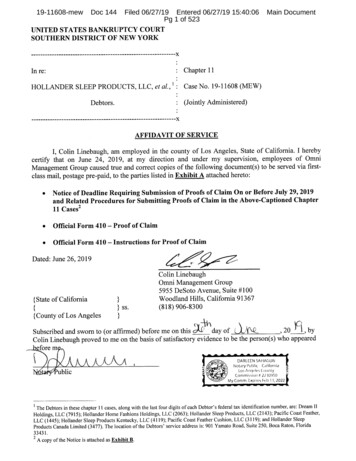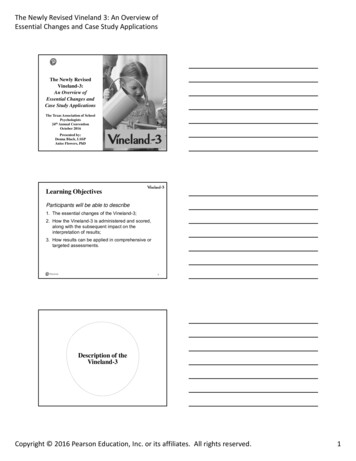
Transcription
ABC YEAR 2 LESSON #5Salt in His Shoes By Deloris JordanOrLong Shot-Never Too Small to Dream Big By Chris PaulMESSAGE TO ABC READERSThe focus of this book is to inspire students to find their sparks, explore their world and learnabout their passions. We discuss how to set goals and talk to goal champions about the stepsyouth can take to achieve their dreams. This lesson helps youth identify, observe andunderstand the steps to success that role models use to achieve their goals; whether they arefamous, or the everyday heroes in student’s lives.Asset Information:This book builds assets from 6 of the 8 categories: Positive Identity-#39 Sense of Purpose and #40 Positive View of Personal Future Support-#1 Family Support, #2 Positive Family Communication and #3 Caring Adults Boundaries and Expectations-#14 Adult Role Models Social Competencies-#32 Planning and Decision Making Commitment to Learning-#22 School Engagement Positive Values-#28 Integrity and #30 ResponsibilityIn our lesson today, our goals are to: Help students explore and discover their sparks (interests, dreams, passions, etc.) Identify their spark champions Set a GPS -short and long term goals, steps to get there, and shifting of gears toachieve their dreams. Identify their goal champions Reflect upon and identify the support students receive from their peers, family, andcommunity. Empower students to provide support to their peers, family, and community.LESSONConversation Starter:Option 1:Introduce yourself and your spark. Tell a story like: I want to tell you about my spark. Myspark is something that I really enjoy. I think it is fun, interesting and it makes me feel goodabout me, and the things I can do. For me, my spark is reading books. You may have knownthat about myself, because I read books with you every month. But even when I am notreading books with you, I use my spark for reading to help me feel good about me, and theProject Cornerstone, ABC Year 2, Lesson 5, Salt in His Shoes1
things I can do well in our world and for our world. My spark has helped me make my dreamscome true. I use my spark to help me follow my dreams, and make my dreams come true.1. Spark: What are some things that you like to do that are: fun, interesting, and makeyou feel good about you? (Note the sparks on a chart paper or white board.)2. Your response to each: Maybe that is your spark.3. Following the sharing of the sparks, offer this observation: Maybe your spark can helpyou find your dream, and make your dream come true!Option 2:Write on the board: My Goals, My DreamsIntroduce yourself and your goal, your dream. Tell a story like: I want to tell you about mygoals and dreams for our time together when I come read to you every month. I want ourtime together to be fun and interesting. I want to be sure that you know I care for you andthat you can count on me. But sometimes my plans for my goals and dreams don’t go as Ihad planned. Sometimes I make mistakes or forget something and I have to be flexible, trysomething new or different. It isn’t easy for me to switch my plan and try something new.But, I have a role model. Someone who helps me stay on track, be flexible, and keep tryinghard so that I can make my goals and dreams come true. This person is: (classroom teacher’sname, ABC Lead, friend). S/he is my goal champion.1. Think for a minute about your goals and dreams. Ask: Do you have a special personwho encourages you, or a role model that you admire who helps you see that you cando great things?2. Respond: That might be your goal champion./ That sounds like a goal champion.Option 3: Older YouthTell a story about using the GPS in your own car. The story we are reading today is about aperson who has a big dream, who put in a lot of effort to make his dream come true, hadsome troubles along the way, but was successful in the end. This story makes me think ofhow important it is to have a plan when we want to make our dreams come true.Have you ever heard of a GPS? Maybe you have one in your car? The GPS in my car is adevice that helps me get where I want to go in my car by giving me directions along the way.I make a plan for where I want to go, and the GPS helps guide me along the way, even if Imake a wrong turn. (Write GPS on the board) When I plan to take a trip in my car, G standsfor the Goal I want to achieve, like getting to school so I can read in your classroom thismonth! The P stands for the Path that I need to take to get here. The S stands for the Shift Iwill make, in case I need to make adjustments. When I make a wrong turn, or something isin the way along my path, the GPS in my car says,” recalculating”. I like my GPS because italways talks to me in a calm voice, it never judges me, or criticizes me, and it offers me goodadvice about how to get back on my path.In our story today, see if you notice how the hero of the story uses his own personal GPS toachieve his goals.G Goal Selection —“Where do I want to go?”P Path/Pursuit of Strategies —“What is the best way to get there?”S Shift/Shifting Gears —”How do I compensate/recalculate when the road gets rough?”Project Cornerstone, ABC Year 2, Lesson 5, Salt in His Shoes2
Option 4:Write the number 10,000 on the board. Read the quote from Michael Jordan. Let studentsknow that it takes 10,000 hours of practice to become an expert.1. Discuss what it says.2. How can failure be part of success?Talk about other famous people who have failed at something only to succeed –Henry Ford, Honda (had no job at Toyota), J.K. Rowlings, and Thomas Edison. Edison triedmore than 2,000 experiments before he got the light bulb to work. When a reporter askedhim how it felt to fail so many times, he replied, “I didn’t fail. I just discovered two thousandways how NOT to make a light bulb.Read the Book:Tell the students you are going to read a book today about someone famous. Have themlisten to understand what he did to achieve his dream and who he talked to, in order to helphim solve his problems. Refer to your Conversation Starter. Ask for students to identify theSPARK or Goal Champions in the book, or listen for the hero’s personal GPS that helps himachieve his goal. Provide a brief introduction of the book’s main character. You can also showa short video that is found on these links:Michael Jordan: http://www.youtube.com/watch?v gfvuF5qf9v0&feature relatedChris Paul: http://www.youtube.com/watch?v FR6VQ6uR2p4&feature relatedDiscussion:Depending on the grade level of the students, choose a few of the following questions:1. What were Michael’s/Chris’s sparks-special interests or passions?2. Is Michael Jordan/Chris Paul a role model? Why?3. Who were Michael’s/Chris’s goal champions/role models in the book?4. What steps did Michael/Chris take to achieve his goal/dream?5. How does Michael’s/Chris’s family support him? (Ask younger students to define theword support: someone who helps, guides, is “there” for you when you need them,etc.)6. Have you ever helped or supported someone? What did you do or say to give support?7. Michael/Chris had a time when he was not sure how to make his dream come true. Heknew what he wanted, but don’t know how to achieve it? Who can you ask to be a goalchampion to help you fulfill your dream?8. Who will be part of your GPS? Who is a goal champion who will help you “recalculate”when you stray off your path?For Students in 3rd-Middle School:If you are going to focus on goal setting, continue the discussion below and choose to do thethe Set Your GPS found in Group Activities:How to set your GPS:1. Ask the students if they know what setting goals mean.a. Help them define a goal as something they want to accomplish.b. This can be a skill, an accomplishment or a destination.2. Ask the students to think of the best way to get there.a. Visualize the dream or goal. What will it feel and look like?b. Shrinking the change –Talk about the small steps that youth can take to leadthem along the right path to achieve their goal. Planning small steps toward theirProject Cornerstone, ABC Year 2, Lesson 5, Salt in His Shoes3
goal allows youth to see change, progress and accomplishment, even whenachieving the ultimate goal may seem far away.3. Ask the students to think of who their goal champion will be. Who are people they canturn to help keep them on course to achieve the goal? On the white boarda. Write the name or names of goal champions.b. Write down what they will do or say to support youth.4. Develop action triggers that list immediate goal steps.a. Action triggers list a time, location or resource needed to take a step towardachieving the goal.b. Action triggers help improve the chance of success by 70%.c. Action triggers should be small, achievable steps that can be measured.5. After your discussion, have students fill out the GPS worksheet. Walk around and helpthose students needing some extra ideas.GROUP ACTIVITIES:Choose one activity that you feel will work best with the students in your class. *Activitiesmarked with an * may be especially suitable for students in grades 1-3.Personal Goal Setting (2nd-Middle School)Materials: Star Worksheet for each child, white board or poster paperTalk with the students about long and short term goals. Sometimes it’s tempting to think onlyabout the big goals, but what you will try to do today, this week or this month are alsoimportant goals. Have the students think about their life in the next 4 weeks.Ask them to think about these steps:1. What would they like to improve or change?2. How are they going to accomplish this? What is their plan?3. Do they need to ask for help from someone? How will they get this help?Pass out the worksheet. Do students see any of their own goals listed? Have them circle goalsthey are interested in fulfilling. Do they have a different goal in mind? Write another goal inthe blank star. In the other stars, have them write 2 action triggers to help them get started.Younger Student Option:For kindergartners or first graders talk about setting a personal goal that they can do andlearn to do it in a simpler fashion. Choose a physical task such as walking. Let them feelsuccessful and then introduce something a little more difficult like galloping. Show them howto do this step by step. If all have accomplished this, teach them to skip. Go much slower.This skill may be hard for some. Talk about practicing and asking for help from a goalchampion.You can also do this with jump rope skills. Start with simple jumping over a rope to individualto two people turning the larger rope to two larger ropes.Project Cornerstone, ABC Year 2, Lesson 5, Salt in His Shoes4
*Shooting Baskets of SupportMaterials: Basketballs-2 or 3, Basketball courtsTake students out to basketball courts. Divide them into 2 or 3 groups and assign an adult toeach court. Have them warm up shooting a basket or two. Ask them to think how theysupport their family member like Michael or Chris’s family supported them. It can besomething they are already doing or something new they would like to do to support theirfamily. With each shot, have them share an idea for giving support.*How Do You Draw Support?Materials: drawing paper, crayons or markersHave students draw a picture of what the word support means to them, either at home or atschool. To help stimulate their creative juices, ask them: What do they do in their family to show their love for one another? How do they show support for their friends or classmates? How does the school show support (care) for their students? What activities or events occur that celebrate support?Have them print the word support on their paper. Extend this activity by adding an acrosticpoem using the word SUPPORT (examples) S-Support; U-UPstander; P-Patient; P-Proud; OOpportunities; R-Respect; T-Together*My DreamsMaterials: My Dream Worksheet, crayonsHave students close their eyes and think about their dreams. What or who do they want to bewhen they grow up? Think about the steps it takes to reach these dreams: athletes practicingskills, professionals attending school, etc What can they do right now to start working ontheir dreams? Pass out My Dream worksheet. Have them draw a picture showing themachieving their dream. Talk about the following:1. Ask for volunteers to share their dream with the class.2. Following each dream description, ask the class to share ideas about things they couldsay or do to help that person’s dream come true.ORHave students write down their dreams on a paper anonymously. Crumble them up andthrow into a basket.Open up one or two and read.1. Ask students what steps would they pursue to make these dreams come true?2. If there were road blocks, how could they shift gears and do something different?3. Who could help them with this goal and be a goal champion?Spark Bookmark-Peer Coaching (3-Middle School)Materials: A bookmark for each student.Michael/Chris received support and advice from his family that helped him reach his goal.Sometimes, caring adults in our lives help us know how to reach our dreams. But, our peerscan also have ideas and helpful advice, as well.Have the students think about their dreams or goals and choose one they would like to focusProject Cornerstone, ABC Year 2, Lesson 5, Salt in His Shoes5
on. Pass out a bookmark and have them complete the following steps:1. Start: Think about a spark or goal. Write it down in the circle.2. My steps for getting there: Think about the steps you can take to pursue your dream orgoal. You can help them by asking:How will you do it?What interests, strengths or passions do you have?What things will you need to help you?Who will you need to help you?When will you start?What obstacles might get in the way?3. Coaching suggestion: When students finish thinking about the steps they will take,have them partner with a classmate and swap bookmarks. Each student should lookover their classmate’s goal sheet and think about their plan. Encourage the students toask questions about one another’s goals and help each other consider other ideas forhow to reach them. By showing interest in your classmates’ goals, you can become agoal champion for your classmate! Once they have returned bookmarks to the originalstudent, have them write down what they learned from their goal champion in the boxat the bottom.4. Send the bookmarks home with the students. Encourage them to share them withtheir parents, talk about their goal and their plan for achieving it. Point out that theirparents may have suggestions and ideas that they can add to the champion’ssuggestion portion. Advice and wisdom from others can be helpful!5. You can also send home a blank bookmark and the family can work on a Family Goalplan.CLOSING*Three Minute Huddle (Led by ABC Volunteer)Ask the students what they will do to start adding the support assets to their life? How will theymake a difference in a friend or family member’s life by showing them support andencouragement? Give a personal example about what you are going to start doing. Remindthem to share their plans with a caring adult (teacher, family member, after-school leader,neighbor, etc.).Three Minute Huddle (Led by ABC Volunteer)GPS: Goal, Path, Switch- Our Goal at recess is to have fun. Our Path is to seek out and invitepeople to play, to smile, to say hello and to use people’s names. We may need to Switch iffaced with rejection or frustration by being understanding, forgiving, and putting a lid on ourbucket so that we can achieve the Goal. We can choose to use GPS to make our dreams cometrue.Project Cornerstone, ABC Year 2, Lesson 5, Salt in His Shoes6
SCHOOL WIDE EXTENSIONSSetting School GoalsGoal setting is an important step on the path to success. Setting group goals is a great way toencourage teamwork and to unite the school in a common mission. Having the whole studentbody participate in a goal will give every child a chance to set a personal goal as well as groupgoal. It is up to you to choose the goal. It could be focused on creating a more Caring SchoolClimate, reinforcing an ABC book such as Have you Filled a Bucket, doing school wideintentional acts of caring or daily acts of service learning. Invite students to determine the goal.Ask students to discuss in classrooms small steps to use to approach achieving thisgoal.Include ways to promote the goal using advertising-posters, messages on bulletinboard or classroom visits.Select goal champions to be contacted for advice (parents, community members,commercial sponsors, etc.).Set action triggers with dates attached.Create a way to chart your progress to the final goal.When problems or road blocks occur, talk about ways to shift gears and “recalculate”ways to achieve the Goal.Once the Goal is met, plan a way to celebrate school wide and thank all of theparticipants.Jar of JoyJar of Joy instruction sheet is attached to this lesson plan or can be found in materials sectionon the website.To notice, name, and celebrate someone special that is a spark champion, goal champion orrole model create a Jar of Joy. This can be a caring adult or student that has done anoutstanding job of showing support for peers and adults at school. Think of parents, coaches,principals, teachers, crossing guards, yard duty, after school staff or students that you wouldlike to recognize.A few weeks before you want to give the Jar of Joy, send out a note to participating staff,students and parents. In the note, ask each child and adult to write a brief note of thanks forthe special person you are honoring. Include a date you want the hearts returned.Then fill the designated jar with the hearts and attach the tag. Present the Jar of Joy to thespecial person during a school wide assembly.Project Cornerstone, ABC Year 2, Lesson 5, Salt in His Shoes7
EXTENSIONS FOR TEACHERSThree Minute Huddle (Led by Teacher)Encourage students to show support for each other verbally and by using intentional acts ofcaring. Have them give out warm fuzzys or read the story, Have You Filled Your Bucket?For those classes choosing to focus on dreams and goals, post their ABC papers on a bulletinboard. Celebrate with them, as they complete the steps to achieve their short term goals.(You never know if you have the next Lucille Ball: She wrote in her journal every day, “I wantto be the funniest person in the world.” or San Jose native and astronaut Steve Smith, who atage 6 drew a picture of himself walking on the moon.)As students read about people in their studies or talk about current events, ask them to lookat these role models and to look at why or what they did to succeed.1. Post pictures of famous people. Ask students if they know what their dreams were?Examples: President and Michele Obama, Steve Jobs, Beyonce, Lionel Messi, JKRowling, Buster Posey, etc.a. Ask if they know what their dreams were?b. What steps did they take to pursue their dreams?2. Post some pictures of everyday role models students would know from school. Can youthink of important people in your lives now, who are role models for you?a. What are their dreams?b. What steps are they taking to achieve their dreams?Classroom EnrichmentJournalsMaterials: Pass out Dream JournalsHave students think about their dreams and goals. What is their GPS? Have them spend timeonce a week thinking about long and short term goals and writing about their progresstowards their dreams. Help them break their dreams or goals into short, clearly defined stepsusing action triggers to set dates for attainable steps. Also have them name a spark or goalchampion and questions to ask them for support. If they encounter obstacles, have themthink and shift gears. What can be done instead?How Do You Spell Support? An Acrostic Poem ActivityMaterials: worksheet for each child, whiteboardYou can do this together as a large group, or pass out the worksheet to do individually or witha partner. If you do this as a group, have the students brainstorm words or phrases that startwith the letter or phrases that contain the letter in the first or second word. Tell students thetop half of the worksheet is for them to describe how they would like to give support to theirfamily or friends. The second part is to describe the support they’d like to receive. They needto think of actions that start with the letter written on the side. For example: S-smiling,singing, silly jokes, saying please, or using phrases like start homework on time.Project Cornerstone, ABC Year 2, Lesson 5, Salt in His Shoes8
Old Wives’ TalesMichael’s mother puts “salt in his shoes.” Talk about this and why she would do it. Define “oldwives’ tales” as a superstition or a belief/practice not based on fact. They are called old wives’tales based on people long ago who gave advice based upon superstitions. Ask the studentsto list other expressions that they have heard. Make a list of them. Some examples are “It’sbad luck to walk under a ladder” or “feed a cold, starve a fever.” Once you have a list createdyou can have the students choose one to write about and illustrate or you can have themcreate their own. For example, “It’s bad luck to .” Or “Wear garlic aroundyour neck to .”HomeworkDream ListsMaterials: Dream List worksheetSend home two copies of the worksheet, one for the students to complete and one for thefamily to complete. They can choose to do a personal list, do one with their family, or evenboth!Encourage students/family to think of all the things they would like to do in their life: placesto explore, talents and skills to learn, cultures to study, ports of travel, experiences toexperience.Tell them they are going to create a life list of dreams. They can write down anything theywant to see, do, or learn, no matter how strange or fanciful. It can be as long or short as theyneed because it is their list. Have them turn in the list. Make a copy for them and keep it in asafe place. Return their lists and tell them this is “their list”. They can put a check by eachdream that they achieve. It is theirs to keep for life. (For more information see Goal Expressbook in Resources.)RESOURCESBooks: Read the book Goal Express The five secrets of goal-setting success by Jim Wiltens.Read the book DREAM a tale of wonder, wisdom and wishes by Susan V. Bosak tofollow up this lesson. It is appropriate for 4th-Middle School. Some of the pages may beused for 2-3rd graders. This book contains many quotes from famous people and has 15world-known illustrators.Upper and middle school students can read Choose Your Life, A Travel Guide for Livingby Karen Gedig Burnett (author of Simon’s Hook)Websites: Look at the website www.booksprogram.com/readalong/salt in his shoes.htm for thebook being read by Stuart Naismith, grandson of Joseph Naismith the inventor ofbasketball.Look at the website: www.myhero.comTo learn more about GPS, check out www.StepItUp2Thrive website.Project Cornerstone, ABC Year 2, Lesson 5, Salt in His Shoes9
Video: Michael Jordan: http://www.youtube.com/watch?v gfvuF5qf9v0&feature related Michael Jordan and GPS: http://www.stepitup2thrive.org/index.php?s Michael JordanChris Paul: http://www.youtube.com/watch?v FR6VQ6uR2p4&feature relatedPictures:Michael Jordan bryant-michael-jordan-over-theyears/Chris Paul -paul-trade-deal-happen/Magazine: Here is the link to the article The Audacity of s/alexander wolff/01/13/obama/Read how Chris Paul decided to write Long Shot:http://sports.espn.go.com/nba/news/story?page CP3Book-091007Newsletters: Ideas for Parents Newsletters#s 2-8 Support category, #18-Adult Role Models, #40,and 45-49 Positive Identity Assets21st Century Skills:Here is a key to the 21st Century skills used in this lesson:21st Century LearningSkillsCollaborationCritical ThinkingCommunicationCreativityProject Cornerstone, ABC Year 2, Lesson 5, Salt in His Shoes10
HOW DO YOU SPELL SUPPORT?Using the letters in the word SUPPORT, write sentences or words thatshow how you give support to your family and/or friends:SUPPORTNow write the words that describe the support you would like to receivefrom family/friends/caring adults/role models in your life.SUPPORTProject Cornerstone, ABC Year 2, Lesson 5, Salt in His Shoes
JAR OF JOYTo notice, name, and celebrate someone special that is a spark champion, goalchampion or role model create a Jar of Joy. This can be a caring adult or student thathas done an outstanding job of showing support for peers and adults at school. Thinkof parents, coaches, principals, teachers, crossing guards, yard duty, after school staffor students that you would like to recognize.Materials Needed: 1 plastic jar (decorated with hearts) with lid Construction paper hearts—3 per child Letter to others participating in the project 1 tag with ribbonA few weeks before you want to give the Jay of Joy, send out a note to participating staff andstudents. In the note, ask each person to write a brief note of thanks for the special personyou are honoring. Include a date you want the hearts returned.Then fill the designated jar with the hearts and attach the tag below with ribbon.
Here is a wonderful quote from Michael Jordan:“I have missed more than 9,000 shots in mycareer. I have lost almost 300 games. On 26occasions I have been entrusted to take thegame's winning shot—and missed. I have failedover and over and over again in my life. And thatis why I succeed.”*July 2009, O magazineWhat does this quote say to you?Project Cornerstone, ABC Year 2, Lesson 5, Salt in His Shoes
MY SPARKMY SPARKMY SPARKMY SPARKMY SPARKMy steps for getting thereMy steps for getting thereMy steps for getting thereMy steps for getting thereMy steps for getting thereSpark Champion’s SuggestionSpark Champion’s SuggestionSpark Champion’s SuggestionSpark Champion’s SuggestionSpark Champion’s Suggestion
Name:Personal Goal SettingSetting short term personal goals is an important skill. Think about your life. What aresome things you would like to improve or change starting today for the next month? Lookat the goals in the stars. Circle 2 goals you would like to work toward in the next 4 weeksor write your own 2 goals in the blank stars.Be ontimeTry anewsportDo mychoresEathealthysnacksKeep myroomcleanPlay withmy sister orbrotherWalkthedogHelp myneighborDohomeworkeach night.Project Cornerstone, ABC Year 2, Lesson 5, Salt in His ShoesSpendless timeon thecomputer
MY DREAMWhen I grow up, my dream is to beProject Cornerstone, ABC Year 2, Lesson 5, Salt in His Shoes
SET YOUR GPSPICTURE YOUR GOAL:How does it feel? What does it look like? Write it here:PLAN OUT THE FIRST SMALL STEPS:1.2.3.Who will be your Goal Champion?How can your Goal Champion help you achieve your goal?Project Cornerstone, ABC Year 2, Lesson 5, Salt in His Shoes
Name:My dream is Books To Read:Family Goal:Classroom Goal:Free-Time Goal:SHORT-TERM GOALSLONG-TERM GOALSSkills to Learn:My Spark Champions:Project Cornerstone, ABC Year 2, Lesson 5, Salt in His ShoesPlaces to Visit:
This month the ABC Parents will be reading the book Salt in his Shoes: Michael Jordan in Pursuit of aDream written by his mother, Deloris Jordan. There are two main themes in this book: following adream and receiving support from family to achieve a goal. The ABC lesson focuses on the assetcategories of Support and Positive Identity.The Support assets are about having people in your life who show love, caring, and who appreciate andaccept you. They are also about having places to go where you feel safe and welcome. Your familysupport provides this for your child at home and in your neighborhood. Here are some questions touse to start a conversation at home: How do you let family members know you love them? How do you send love messages?What is your favorite thing about your family?How can your family support each other more?What family activities would you like to do?The Positive Identity assets are about sense of purpose in life and a positive view of our future. Foryour child, this asset means thinking about their life and its positive purpose. Research shows thatchildren can identify their sparks- interests, dreams, or passions by the age of 10. Here are someconversation starters to use at home to talk about goals: What is your biggest dream? What matters to you? What sparks your interest? What do you care deeply about? What is your favorite thing to do, and how can I help you do it? What help do you need to reach your goals? Who will be your spark or goal champion (helps with taking steps to achieve a dream) You are an essential positive force in helping your child feel empowered as s/he learns to dream andset goals. If you would like more information about sparks go to www.IgniteSparks.org .As we support our children, we must continue to model for them what it means to have a sense ofpurpose in life. Together, we can create a stronger school community where all of our students areaccepted and encouraged to dream.Sincerely,ABC VolunteerTelephone/EmailOn the back of this letter is The Life Dream List. It will help you start a conversation aboutgoals and dreams. It can be done as an individual or family list.
LIFE DREAM LIST FOR YOU OR YOUR FAMILYThis month in our ABC lesson, we discussed dreams and goals. The assignment todayis to write a list of ALL the things you and/or your family would like to do in your life:places to explore, talents and skills to learn, cultures to study, ports of travel,experiences to encounter, etc. Create a life list of dreams. Anything can be writtendown, no matter how fanciful it may seem. As you achieve your dream, put a colorfulcheck by each one!EXPLORECLIMBVISITSTUDYEXPERIENCESSKILLS TO LEARNGENERALBOOKS TO READPEOPLETRAVELProject Cornerstone, ABC Year 2, Lesson 5, Salt in His Shoes
Project Cornerstone, ABC Year 2, Lesson 5, Salt in His Shoes 2 things I can do well in our world and for our world. My spark has helped me make my dreams come true. I use my spark to help me follow my dreams, and make my dreams come true. 1. Spark: What are some things that you like to do that










